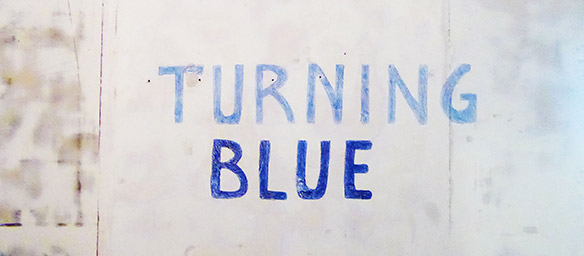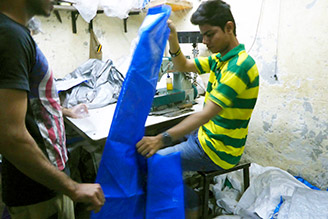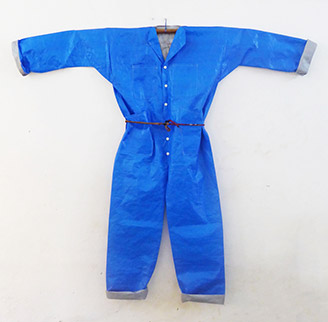Turning Blue
Clark House Institute, Bombay 2015-16
“One of the many highlights at Turning Blue are two papier mache globes made using the pages of business newspapers. While one depicts the landmark sites in the history of indigo, the other globe indicates the places where pthalo blue and real indigo are traded, including Europe, USA and China.”
– Feature article by Soma Das in the Hindustan Times, 2016
Invited to create an installation at Clark House in Bombay, I decided to make the art for it in Bombay itself. I spent three months as an artist in residence there working on the exhibition, following threads from my research for a book.
The book is about the centuries of global trade in color pigments. In my research I learned that the Spokane River, only hours east of my studio in Fall City, WA, has become polluted from the recycling of printed magazine pages and newspapers. The recycling mill washes the ink from pre-used paper with water, treats the water and then discharges the effluent into the Spokane River. Once the new (multi-million dollar) plant was up and running, fish began to die. It has become clear that residue from blue and green ink, containing trace amounts of PCBs, have been poisoning the river. A known carcinogen, PCBs have been outlawed for decades, but are allowed in certain chemicals as the “unintended” consequence of manufacture. The pigment phthalo blue is by far the leading blue sold globally, and is used extensively in blue and green ink. Phthalo blue is almost entirely manufactured in India, by companies all based in Bombay. In my articles I followed the Indian ink to the fish kill in Spokane: Dangerous colors and the poisoning of the Spokane River and What will it take to clean up a poisoned river?. The articles will be included in a forthcoming book on the Spokane River from University of Washington Press.
A century ago in 1917, a young lawyer, Mohandas K. Gandhi, returned for the first time from South Africa to support Indian workers. The workers were being forced to grow indigo by British plantation bosses. But plant-based indigo was being outpriced in the world market by the German synthesized chemical indigo. With no market for their crop, the farmers went unpaid for their work, and were starving to death. Gandhi’s first use of satyagraha, non-violence, on Indian soil began with the striking indigo workers and led steadily and ultimately to India’s independence. India had been the leading producer of blue in the world for a century before 1917 and now a century later, has recaptured that market with another blue pigment, albeit a synthetic one.
In Bombay I conducted interviews with the CEOs of the world’s largest phthalo blue pigment producing companies. I began collecting copies of the financial section of the daily Indian newspapers, a conspicuous pink color paper (they have followed the lead of London’s Financial Times which began printing on salmon pink paper in the 19th century). I used the papers to layup two large papier mache globes. One would show how plant-based indigo moved around the world, the other phthalo blue. It seemed right to create the globes from the papers that carry news of such things. It was precisely this sort of newsprint that the Spokane paper mill uses to create recycled paper.
Besides pigmenting inks, dyes and paints, phthalo blue is used to produce the ubiquitous blue tarps that cover leaking roofs everywhere and serves as impromptu shelter for millions around the world. I decided to have a jumpsuit sewn out of the blue tarp material for the installation, using a pattern developed around the time of Gandhi’s work with indigo farmworkers. The design was created by the Italian artist who took the name Thayaht and created the ‘Tuta’, a one-piece androgynous outfit. The suit in my installation was sewn by young men working in the section of the Bombay outdoor market specializing in the blue tarp material.




